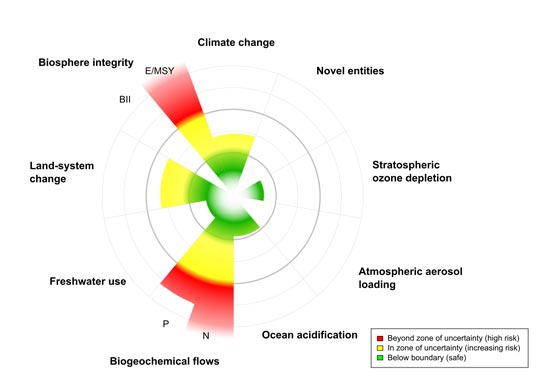Saving the Planet from Too Much Man Made Nitrogen
By Kristina Heinemann

Planetary Boundaries: A Safe Operating Space for Humanity, Stockholm Resilience Centre, Stockholm University (http://www.stockholmresilience.org/)
Environmental sustainability is all the rage right now. Much of the focus when talking about sustainability is on the global carbon cycle and climate change, but there are other global cycles that have been disturbed to an even greater extent than the carbon cycle. Since the Industrial Revolution biogeochemical flows of nitrogen and phosphorus or the Earth’s nitrogen and phosphorus cycles have been disrupted even more than the carbon cycle. Biogeochemical flows of nitrogen and phosphorous is a scientific way of talking about the pathways and interactions the elements nitrogen and phosphorus have with the physical and biological world. Human beings have altered these pathways and systems dramatically to the point that we and the planet are at great risk. You can see this represented in the figure above – we are clearly in the “red zone” when it comes to disturbance of nitrogen and phosphorous cycles!

One dramatic consequence of too much nitrogen – the Peconic River Fish Kill, Riverhead (NY) Yacht Club, June 15, 2015 Photo credit: Andrew Seal
One important source of “too much nitrogen” in the coastal areas of our Region — New York, New Jersey, and the Caribbean — are conventional onsite wastewater disposal or septic systems many of which were never designed to remove or reduce nitrogen. We face a serious need to upgrade many of these systems to technologies that will reduce nitrogen flow to our estuaries and coastal ecosystems.

Being SepticSmart Also Means Using Appropriate and Well Designed Septic Technology To Protect Water Quality
SepticSmart Week, which kicks off this year on Sept. 21, will educate public officials and the public at large about the importance of using well designed and appropriate septic treatment technology that is protective of water quality. Advanced onsite treatment systems can remove as much as 74 percent of nitrogen before it enters the environment. Part of my job at EPA is to help state and local governments meet this need. As an example Suffolk County, New York declared nitrogen public enemy #1 and launched an advanced treatment septic demonstration program to install and test nitrogen removal systems on almost 20 residential properties throughout the County.
EPA, in cooperation with states and partners, works hard during SepticSmart Week and year-round to educate local decision makers, engineers and homeowners about managing and upgrading their wastewater infrastructure in order to protect the waters they swim in, fish from, and drink. (By the way this also happens to be National Estuaries Week – take a look at all the great resources aimed at restoring estuaries like the Long Island Sound, Peconic Bay, the New York – New Jersey Harbor, Barnegat Bay, Delaware Estuary, and San Juan Bay in Puerto Rico at: https://www.estuaries.org/national-estuaries-week !)
About the Author: Kristina Heinemann is EPA Region 2’s Decentralized Wastewater Treatment Coordinator and lives on Long Island’s North Shore where she is the not-so-proud owner of two antiquated cesspools one of which often acts more like a holding tank than a wastewater disposal system!


